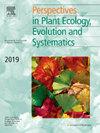Winter annuals not only escape but also withstand winter droughts: Results from a multi-trait, multi-species approach
IF 2.9
3区 环境科学与生态学
Q1 ECOLOGY
Perspectives in Plant Ecology Evolution and Systematics
Pub Date : 2025-02-08
DOI:10.1016/j.ppees.2025.125849
引用次数: 0
Abstract
Winter annual plants are a dominant life form in drylands. They evade seasonal drought through their life history, but are also exposed to drought within their growing season. Across species, winter annuals differ in traits allowing them to reproduce before a drought occurs (drought escape) as well as in traits minimizing tissue dehydration (drought avoidance) and/or maintaining functioning under drought (drought tolerance). It is yet uncertain how these traits are coordinated and influence winter annuals’ performance responses to drought within the growing season and their distribution along rainfall gradients. Understanding these mechanisms is crucial to predict global change impacts in drylands. We measured 22 traits hypothesized to influence whole-plant performance responses to drought in 29 winter annuals common in the Eastern Mediterranean Basin. We examined trait syndromes and linked species’ strengths of these trait syndromes with their fecundity responses to an experimental within-season drought, their maximum growth rates (in 18 species), and their distribution along a rainfall gradient. Four trait syndromes emerged: Two were largely consistent with drought avoidance and tolerance, while the other two consisted of traits considered to confer drought escape. Both escape syndromes were differently associated with plant size and therefore referred to as small and tall escape syndrome. Species with a pronounced small escape syndrome showed, albeit weakly, higher fecundity losses under experimental drought. Both species with a pronounced avoidance or tall escape syndrome exhibited higher growth rates, but only annuals with pronounced avoidance traits tended to occur in moister conditions. Our findings highlight that winter annuals, despite their common life history, exhibit several trait syndromes conferring them similar ability to cope with drought in the growing season. Consequently, increasing within-season drought with global change may hardly affect community composition of winter annuals.
冬季一年生植物不仅能逃避而且能抵御冬季干旱:来自多性状、多物种方法的结果
冬季一年生植物是旱地的主要生命形式。它们一生都在躲避季节性干旱,但在生长季节也会面临干旱。在不同物种中,冬季一年生植物的特征不同,这些特征使它们能够在干旱发生之前繁殖(干旱逃避),以及最大限度地减少组织脱水(干旱避免)和/或在干旱下维持功能(干旱耐受性)。目前尚不清楚这些性状如何协调并影响冬季一年生植物在生长季节对干旱的表现响应及其沿降雨梯度的分布。了解这些机制对于预测全球变化对旱地的影响至关重要。在东地中海盆地常见的29种冬季一年生植物中,我们测量了22个性状,假设这些性状会影响整个植物对干旱的反应。我们研究了性状综合征,并将这些性状综合征的物种优势与它们对季节内干旱的繁殖力反应、它们的最大生长率(在18个物种中)以及它们沿降雨梯度的分布联系起来。出现了四种性状综合征:两种与干旱避免和耐受性基本一致,而另外两种由被认为赋予干旱逃避的性状组成。这两种逃逸综合征与植物大小的关系不同,因此被称为矮高逃逸综合征。具有明显的小逃逸综合征的物种在实验干旱下显示,尽管弱,较高的繁殖力损失。具有明显回避或高逃避综合征的两种植物均表现出较高的生长速率,但只有具有明显回避性状的一年生植物才倾向于在潮湿条件下生长。我们的研究结果强调,尽管它们有共同的生活史,但冬季一年生植物表现出一些特征综合症,使它们在生长季节应对干旱的能力相似。因此,随着全球变化而增加的季内干旱几乎不会影响冬季一年生植物的群落组成。
本文章由计算机程序翻译,如有差异,请以英文原文为准。
求助全文
约1分钟内获得全文
求助全文
来源期刊
CiteScore
6.50
自引率
0.00%
发文量
28
审稿时长
67 days
期刊介绍:
Perspectives in Plant Ecology, Evolution and Systematics (PPEES) publishes outstanding and thought-provoking articles of general interest to an international readership in the fields of plant ecology, evolution and systematics. Of particular interest are longer, in-depth articles that provide a broad understanding of key topics in the field. There are six issues per year.
The following types of article will be considered:
Full length reviews
Essay reviews
Longer research articles
Meta-analyses
Foundational methodological or empirical papers from large consortia or long-term ecological research sites (LTER).

 求助内容:
求助内容: 应助结果提醒方式:
应助结果提醒方式:


